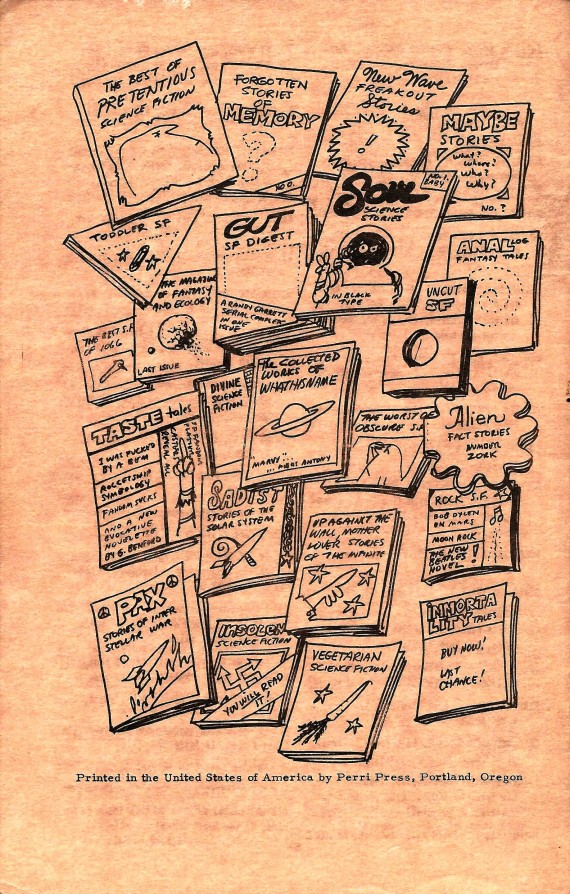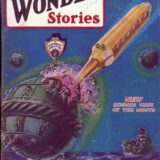Fanzine reviewed: THE ALIEN CRITIC #5

The Alien Critic: an informal science fiction & fantasy journal (#5) May 1973
Faned: Richard E. Geis
The BCSFA archive contains 18 issues of Richard E. Geis’ SCIENCE FICTION REVIEW which came out in the 1970s and 1980s.
Last week I described an earlier incarnation from August of 1955. The magazine folded at issue #25. Sometime in the early 1970s Richard revived the zine under the title RICHARD E. GEIS, I guess in order to emphasize it being his extremely personal SF&F literary review zine. With issue #4 the title was changed to THE ALIEN CRITIC, and eventually to THE SCIENCE FICTION REVIEW.
My archives closet currently being stuffed and somewhat in disarray, I rummaged through the American zines section till I came across issue #5. Good enough, I figured. A random sample to contrast and compare to his effort of nearly twenty years earlier. Had he matured as a critic?
Blown away I am. Now I see why he became a celebrated “amateur” critic in his day. This is especially interesting to me because, in my four issues to date of OBIR Magazine (OBIR = Occasional Biased Ignorant Review) I have attempted to give my honest, personal reaction to Canadian Specfic I’ve read of late. Honest to the point of stream of consciousness writing at times. Geis very similar, but more visceral, pulls no punches whatsoever, whereas I’m still feeling my way toward honesty while being ultra-conscious of avoiding any silly tendency to criticise for the sake of criticism, for the sake of effect. More difficult than you might think.
What saves me from falling into the trap of seeing myself as a “professional critic” who deserves to be read and respected for “putting authors in their proper place in the literary scheme of things” is that I don’t actually care what my readers think of me and my opinions. All I want to do is share my perspective based entirely on how the work reviewed impacts me, and encourage my readers to check out the works for themselves and form their own opinions, which may be quite different from mine.
Geis, I think, shared my delight in having one’s sense of wonder stirred. At times he seems positively giddy in his excitement over what he enjoys reading. On the other hand, he seems to feel betrayed when something doesn’t live up to his expectations. At one point he comments: “Somebody should write an article for THE ALIEN CRITIC on the theme of ‘The Writer as Sadist—the Reader as Masochist.’” Reading what thrills is exciting. Reading what disappoints is drudgery. But can’t complain. Not as if anyone forced us to adopt this unusual hobby.
Like myself, Geis relied on ARCs (Advance Review Copies) sent as “freebies” by authors and publishers. I, being a fast reader but a slow thinker, can barely handle the few copies I have received so far. Geis, having proven himself to pros and fans alike, was inundated, to put it mildly.
“At first it’s lovely to have two or three publishers send books for review. You can handle that many. No sweat. But then, as your magazine becomes known, more publishers send more books. And more. And MORE!”
“Then come the screaming Guilties and the shouting Obligationals with pitchforks a-prodding … In sheer desperation you fall upon the device of a ‘Books Received’ list—THE ARCHIVES.”
At the back of the issue he lists the number of novels and anthologies which had come to his mailbox since his previous issue; no less than 136 books. Talk about pressure!

Furthermore, in this particular issue he sets about the task of reviewing each and every story in Harlan Ellison’s anthology AGAIN, DANGEROUS VISIONS. Something like 860 pages of stories. Wisely, Geis reviews a few at a time, with other items—like his own interlineation “Ten years of writing rejection slips is nature’s way of telling you to stop writing.”—as well as short articles and other reviews, filling the gaps.
Overall Geis is impressed: “I’m awed. What a package! What a hell of a lot of work this is/was. What a smorgasboard of speculative fiction; a rich variety of good, bad, wonderful, lousy.”
Bad? Lousy?
“Too many of the writers got the galloping Deep Thoughts and a common young writer’s disease known as the Aggravated Litrachoor … Personally, as a reader, I don’t much like being obviously experimented upon. Nor do I like the inherently patronizing attitude of the writer who is intent on teaching me lessons.”
For example, in reviewing EPIPHANY FOR ALIENS by David Kerr, a story about a woman scientist willing to have public sex with a surviving Neanderthal in order to atone for what modern man did to drive them to near extinction, only to be killed by the Neanderthal and consequently trigger an outraged assault on the cave wiping out the last of the species, Geis has this to say:
“They don’t make straw men like they used to. The current set are wearing out. But that’s because they’re used to beat dead horses all the time.”
Another example of the way Geis reacts to a story he doesn’t like: “I shouldn’t be writing a review of Chad Oliver’s KING OF THE HILL. I’m sleepy, grumpy, and sick to death of message fiction.”
“The messages are almost always Right-Thinking messages—SAVE OUR PLANET, STOP POLLUTING, BE NICE, THE MASSES ARE ALWAYS WRONG.”
“When is somebody going to publish a story that says pollution is in the long run a good thing, killing our fellows is okay, politicians are admirable people, and the average citizen is pretty shrewd?”
“That IS a dangerous vision. But I do not think I will hold my breath until it hits print.”
Then there’s BED SHEETS ARE WHITE by Evelyn Leif, described by Geis as “a ridiculous … knee-jerk Activist anti-establishment story … vision of repression … control of the country and the people has reached the extreme of requiring everything be white—roads, buildings, clothes … Sunglasses have been outlawed and looking up at a blue (or black, night) sky is illegal; it could give a person ‘unacceptable’ thoughts.”
“I must confess to unacceptable thoughts as to where Mrs. Leif should have stuffed this story.”
“I begin to suspect Harlan has a Liberal-Activist-Relevant button that accidentally gets pushed now and again. It turns off his critical facilities.”
It may be a matter of personal taste. Elsewhere Geis admits “I’m often baffled by surrealistic writing. I resent it because it is so often what might be called Private S-F; only the author knows for sure what it means.”
On the other hand, he has nothing but praise for Ursula K. Le Guin’s THE WORD FOR WORLD IS FOREST. Its premise that humans are insane because we can’t dream properly, and that we would inevitably exploit any alien race which can, would appear to be an allegory of the white man’s treatment of “lesser” races and consequently fall within the category of “Aggravated Litrachoor.” In fact Geis considers it “the work of an excellent writer. All the elements of a fine story are in it, meshing, humming smoothly, enveloping the reader … Hugo quality science fiction. One of the year’s best stories.”
And he really admires Kate Wilhelm’s THE FUNERAL, calling it “quietly one of the more powerful, better stories in this huge volume.”
“She can inform by indirection; by the simple act of casually (it seems casual, actually, it’s cunning) describing a room or a person or a set of clothing she adds to a slowly emerging deduction of terrible repression and fear … she’s a superior writer … You may not enjoy the ending, but you will enjoy the skill and insight in its telling.”
In summing up the anthology Geis writes “AGAIN, DANGEROUS VISIONS is a monument to Harlan’s guts, vision and professionalism … and it’s biodegradable.”

Not all of the other reviews necessarily deal with the higher literary end of SF. The Kit Pedler/Gerry Davis novel MUTANT 59: THE PLASTIC EATERS is about … plastic eating bacteria and the threat they pose to civilization.
“Fast, slick, gripping, plausible; a very good could-be-now s-f disaster set in London … There’ll be a movie of the book … A humdinger. Entertaining.”
All of the above tells me Geis and I are similar in some ways, intolerant of “message” stories and appreciative of “ripping good yarns.”
However, he printed 3,000 copies of THE ALIEN CRITIC and sold them by subscription, with some available in book stores. I create a PDF of each issue of OBIR and post it online for anyone who wants to download it for free. His reviews tended to be longer than mine, and a lot more of them per issue. His quick-flowing persona gives you the impression you are enjoying a conversation with him. Me? All I can say is I try. Someday I hope to be as good a reviewer as Richard E. Geis and, even better, as entertaining.
A significant difference between our two zines is that mine consists strictly of personal reviews of stuff I’ve read, whereas, to judge by issue #5, Geis throws in wonderful articles by other writers. For example, an interview with Fritz Leiber conducted by Paul Walker.
Leiber credits an element of luck in the development of his writing style in that both parents were Shakespearean actors. “I’m told I learned most of HAMLET while my father was learning it. I was four years old … I think I was lucky to have had such a good early influence on my style.”
“Speaking of luck, I was also lucky to correspond intensively with H.P. Lovecraft during the last eight months or so of his life. He helped instill in me the need for honesty, conviction, care and polish and scholarship in writing.”
When asked “Why do you think supernatural horror stories appeal to people?” Leiber replied “Supernatural horror stories, seriously written, contain as many valid human insights as any other sort of fiction … all fiction is fantasy, from Proust to Edgar (and William) Burroughs … I’m a better writer than Lovecraft and more versatile than Dunsany … and always damn serious.”
“I should add that only second- and third-rate writers consider sf, supernatural horror, sword-and-sorcery, etc. as genres—word games to be played in idle moments at half-speed creativity and care. Consult, say, Ted Sturgeon, Heinlein, or Philip K. Dick.”
Hmmm. That almost reads as if Leiber is calling those writers second-rate. In truth I believe he is offering them as examples of first-rate writers. Earlier in the interview he comments “Heinlein is my favourite sf writer by several lengths, with real goodies like Wells, Herbert Best, Joanna Russ, Stapledon, Sturgeon, and Kornbluth trailing …” so I’m pretty sure he is advocating would-be writers consult Sturgeon, Heinlein and Dick in order to learn how to write SF&F properly.
In discussing his initial interest in fringe sciences Leiber credits his University of Chicago courses in genuine sciences with pulling him away from the supranormal, but also “the influence of Lovecraft, very much a materialist and champion of scientific approach.”
This aspect of Lovecraft is absolutely true yet curiously unknown to most of his fans and critics. I was once lectured by a born-again Christian part-time pastor (a co-worker of mine in the warehouse where I worked) on the subject of Lovecraft’s paganism and his alleged goal of opening the world to a race of demons. Hell no. Lovecraft was a strict scientific rationalist who couldn’t abide superstition. Amazing how many people don’t know that. Sigh.

Anyway, for me the highlight of the issue was an article by Jack Chalker titled IRVIN BINKIN MEETS H.P. LOVECRAFT.
Seems Chalker received a phone call. “You write that bibliography of H.P. Lovecraft?”
“I admitted that I had indeed done so.”
“Well, I got everything in it plus 50%.”
“At that point I spilled the coffee.”
Turns out that Binkin, an elderly Jewish bookseller operating out of Red Hook in Brooklyn, had acquired the Lovecraft collection from the estate of Phillip Grill, the world’s greatest collector of Lovecraftiana. “His collection is far larger than Derleth’s, and, indeed, is larger than Derleth’s and Brown University’s put together.” It filled hundreds of boxes.
“As Binkin poured over the contents of each box, he suddenly came across a photo of Lovecraft—and recognised him! When living in Brooklyn during his marriage, Lovecraft had often dropped by Binkin’s shop. Binkin remembered him clearly—even what he bought, although Binkin keeps no real records and the visits were forty years gone—‘because of the odd name,’ he says, ‘and the jaw—longest jaw I ever saw, Chalker, honest to God.’”
At one point Binkin began reading a huge pile of Lovecraft’s letters. “Binkin became fascinated with Lovecraft. He didn’t care for the stories all that much, but, as Derleth found to his profit, Lovecraft was a tremendously fascinating man in and of himself. Binkin became, in one reading, one of the world’s greatest authorities on H.P. Lovecraft.”
Naturally Chalker couldn’t resist accepting an invitation to see the collection. “Reaching into the boxes was like reaching into a time machine … Fanzines—almost a complete file of Lovecraft’s THE CONSERVATIVE, plus many other fabled fanzines of the teens and twenties. From 1912 was Lovecraft’s earliest fanzine. THE RHODE ISLAND JOURNAL OF ASTRONOMY, a little hectographed quarter-sized zine which must, surely, be the only such left in the world.”
It should be noted that here Chalker is not referring to SF fanzines as such, but self-published newsletters which had been quite common even before the turn of the century. This is why amateur press associations predate the rise of science fiction fandom.
Essentially every Lovecraft publication known, and some previously unknown, were to be found, often in multiple, pristine copies, along with myriad letters and photographs. Chalker arranged for a friend of his, Mark Owings, to catalogue the collection, producing the definitive bibliography of Lovecraft’s works.
As of 1973 Binkin was in no mood to sell the collection. He had already turned down an offer of $30,000. Today it would be worth much more. Binkin was in his seventies back then. What happened to the collection when he died? Was the world’s largest collection of Lovecraftiana kept intact? Or auctioned off and widely dispersed? I confess I am afraid to research.
At any rate I must say I found this issue of THE ALIEN CRITIC a treat to read. Geiss was the best kind of SF&F critic, an enthusiastic critic eager to reignite his sense of wonder every time he opened a book. Splendid chap.
ART CREDITS:
#1 (Cover) – Jim Kirk
#2, 3 & 4 – Jim Kirk
#5 – William Rotsler

BY THE WAY:
You can find a fantastic collection of zines at: Efanzines
You can find yet more zines at: Fanac Fan History Project
You can find a quite good selection of Canadian zines at: Canadian SF Fanzine Archive
And check out my brand new website devoted to my OBIR Magazine, which is entirely devoted to reviews of Canadian Speculative Fiction. Found at OBIR Magazine
And while checking out OBIR, click on the sub-heading “Polar Borealis Magazine” to see the first issue of my semi-pro SF&F fiction zine.











